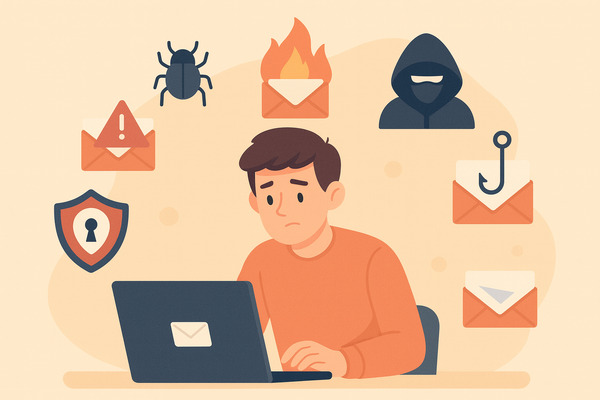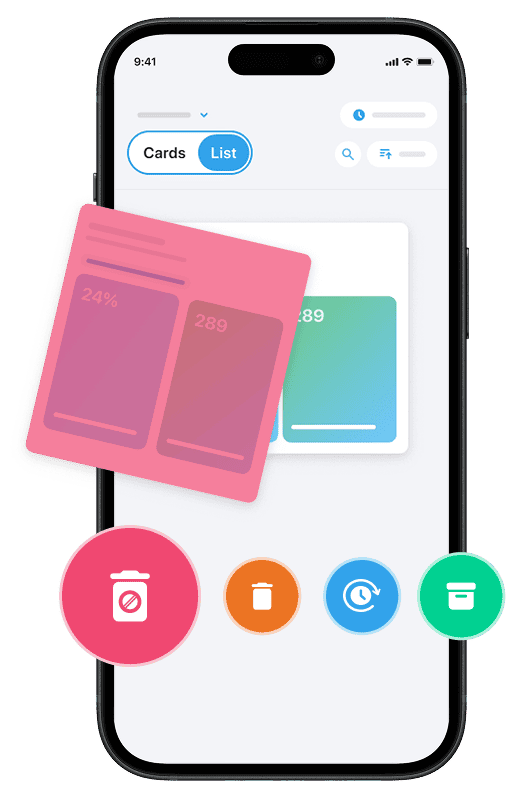Email threats are rapidly evolving, becoming more sophisticated and targeted than ever before. In 2025, malicious actors use email as their primary vector to deliver phishing emails, exploit security vulnerabilities, and launch cyberattacks that endanger your data and privacy. Whether it’s spam emails flooding your inbox or advanced phishing schemes impersonating trusted brands like Microsoft, these scenarios serve as a stark reminder of the danger of spam emails. Clever scams delivered via text messages and social media also illustrate how cybercriminals employ a variety of tactics to bypass traditional defenses.
Understanding the main types of email threats is essential for protection. These include phishing, spam, and business email compromise. No matter the size of your organization, awareness is your first defense.
With global threat intelligence and advanced security tools, you can detect, report, and stop evolving cyber threats.
And one of the best ways to keep your email completely free of spam and unwanted messages that could harm your PC or mobile device is by using a reliable tool that clears all spam in just one click — like our free Cleanfox app.
AI-Powered Phishing Attacks
Deepfake Technology in Phishing
By 2025, deepfake technology has revolutionized phishing attacks, enabling cybercriminals to create hyper-realistic audio and video imitations of trusted individuals. AI-generated deepfakes can mimic an executive’s voice or appearance during calls, tricking employees into sending money or sharing sensitive information.
This advanced form of vishing (voice phishing) has successfully tricked 30% of organizations surveyed, highlighting its growing threat. Combining traditional social engineering with cutting-edge AI, these impersonations are increasingly difficult to distinguish from genuine communications. To counter this, organizations must enhance their email and call verification processes to identify such scams effectively.
Context-Aware Scamming
AI-powered phishing attacks now use massive amounts of public data — from social media to LinkedIn profiles.
This lets attackers create context-aware scam messages tailored to your job, projects, and communication style, making them look highly convincing.
Cybercriminals constantly refine their messages in real time, using polymorphic techniques to change email content and malicious links. These evolving tactics often bypass traditional spam filters and security systems. This level of personalization greatly increases the risk of email scams, highlighting the need for awareness and advanced protection in 2025.
Additionally, the distinction between junk vs spam emails becomes significant, as malicious spam emails can contain sophisticated threats that evade detection.
Advanced Ransomware via Emails
Say goodbye to spam, clutter, and chaos.
Our smart email cleaner filters out junk, organizes your inbox, and helps you focus on what really matters.
✅ Block spam automatically
✅ Organize emails by priority
✅ Keep your inbox clean
✅ Clean old emails you don’t read
📱 Available on the App Store and Google Play.
Encrypting Essential Operations
Ransomware attacks have significantly evolved, targeting the core operations of organizations. These attacks aim to encrypt critical data and systems vital for daily business functions. Typically, they originate from sophisticated phishing emails that deceive employees into opening malicious attachments or clicking on harmful links. This grants attackers initial access to the network. Once inside, ransomware operators conduct thorough reconnaissance to identify the most valuable data and systems. They then encrypt these resources, effectively crippling the organization’s ability to function efficiently.
This calculated approach of targeting essential operations intensifies the pressure on victims to pay the ransom. The potential financial losses from downtime and data loss can be devastating for any organization. To mitigate such threats, organizations should implement email security best practices, including educating employees about suspicious emails and monitoring for unusual activity.
Double Extortion Schemes
One of the most alarming trends in ransomware is the rise of double extortion schemes. Attackers not only encrypt data but also exfiltrate sensitive information, threatening to publicly disclose it unless their demands are met. This tactic significantly enhances their leverage, as the reputational damage from a data breach can be as destructive as losing access to critical systems.
Double extortion has become a defining feature of modern ransomware attacks. Many groups now rely on this approach to maximize profits and ensure victims feel pressured to comply with their demands.
Business Email Compromise (BEC) Evolution
CEO Fraud Enhancements
Business Email Compromise (BEC) remains a major concern for organizations of all sizes. Attackers continually refine their strategies. By 2025, CEO fraud schemes have become more sophisticated, using pretexting — fake urgent scenarios that trick employees into sending money or sharing sensitive data.
Unlike traditional phishing, which depends on volume, BEC attacks are highly targeted and often focus on executives or finance teams.
Attackers conduct meticulous research on their targets—often through social media platforms or compromised email accounts—to craft messages that appear authentic. These messages frequently reference real deadlines, ongoing business deals, or internal protocols. This level of precision makes it extremely challenging for employees to differentiate between a scam and a legitimate request, significantly increasing the success rate of these credential harvesting attacks.
Automated Impersonation Attacks
The rise of generative AI has revolutionized BEC campaigns, making automated impersonation a standard tactic. Attackers no longer need to write each message manually. AI tools now let them scale fast with personalized, convincing emails.
These AI-powered BEC attacks are highly adaptive, capable of responding to replies and maintaining multi-message threads that appear authentic. Additionally, advanced automation allows threat actors to generate localized messages—sometimes in non-English languages—that reduce suspicion among local executives. This evolution means that traditional spam filters or manual oversight are no longer sufficient defenses.
Organizations now require modern email security solutions powered by AI-driven threat intelligence and behavioral analysis to detect these increasingly convincing yet malicious messages. Moreover, adopting zero trust email protection frameworks can add an essential layer of security, ensuring that all communications are rigorously vetted before being delivered.
Conclusion
As email threats continue to grow more sophisticated in 2025, from AI-powered phishing attacks to advanced ransomware and evolved Business Email Compromise (BEC) schemes, staying vigilant is essential. Protecting your data, accounts, and organizational operations demands not only awareness but also the deployment of robust email security solutions, such as advanced threat protection and spam filters. Employing tools for secure document sharing also plays a vital role in minimizing unauthorized access to sensitive files.
Acting swiftly by reporting suspicious messages and utilizing global threat intelligence can significantly reduce the risk of costly breaches. Cybersecurity is a continuous effort. Stay equipped with the latest tools and knowledge to fight evolving email threats.
FAQ
What are the most prevalent types of email threats in 2025, and how can users protect themselves against these attacks?
In 2025, prevalent email threats include phishing with AI-generated emails, malicious attachments, and callback scams. Users can stay safe by verifying senders, avoiding suspicious links, and using strong email security tools like DMARC. Also, knowing whether opening an email can lead to hacking — and taking proper precautions — helps protect both personal and organizational security.
How do attackers use AI in email campaigns to make phishing attempts more convincing and effective?
Attackers use AI to create highly personalized phishing emails by analyzing targets’ online data, crafting convincing narratives, and mimicking legitimate communications. AI can generate hundreds of unique emails that evade basic spam filters, making them more believable and effective.
What are some common indicators that can help identify phishing emails, and how can users differentiate them from legitimate emails?
Common indicators of phishing emails include suspicious sender addresses, generic greetings, urgent language, requests for personal information, and suspicious links. Users can differentiate them by verifying sender domains, checking for spelling errors, and avoiding urgent actions.
Legitimate emails are personalized and free of grammatical errors.
How do multi-channel attacks, such as combining email with voice or video, enhance the sophistication of phishing campaigns?
Multi-channel phishing attacks enhance sophistication by combining email with voice or video to create seamless, believable narratives exploiting trust, urgency, and familiarity across platforms. This approach uses personalized, coordinated interactions that evade detection, build trust, and increase success by targeting victims persistently via email, SMS, calls, social media, and apps. For instance, integrating smishing attacks with email campaigns amplifies effectiveness by leveraging both text messages and emails to deliver fraudulent content in compelling ways.



